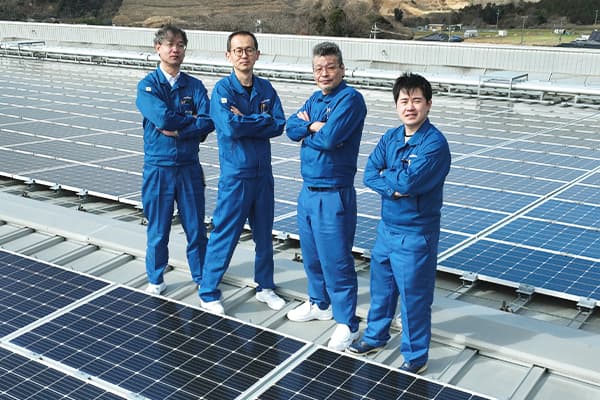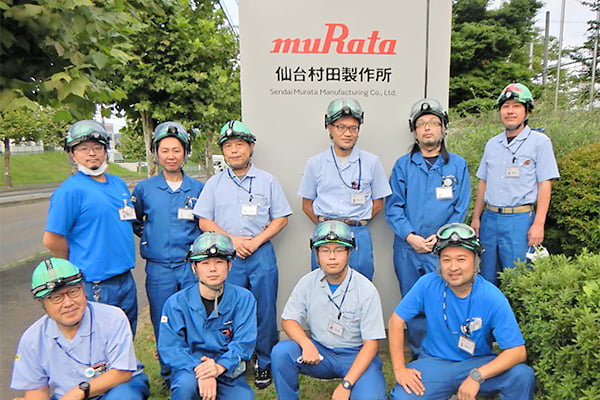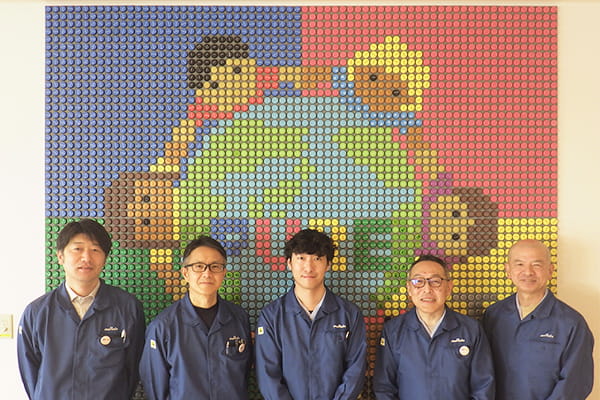Murata is striving to promote renewable energy through a wide range of measures at its locations in Japan and overseas. This section presents a detailed case study of the cooperative pilot project between Murata headquarters and a group company that led to the introduction, in 2021, of a system combining solar panels, storage batteries, and control software (efinnos*1) aimed at maximizing the effectiveness of adopting renewable energy. During daylight hours when solar generation was possible, this system monitored changes in power generation and weather conditions to supply the plant’s own electricity requirements while efficiently charging and discharging the storage batteries, steadily reducing dependence on the power grid. During the night, the system recharged the batteries in preparation for daytime electricity demand, helping to stabilize the plant’s dependence on the power grid. In 2023, Murata completed the installation of this system at four group companies, achieving a total annual reduction of 2,265 t in CO2 emissions across five group companies.
Link: About efinnos
As the system was progressively implemented at each group company, several spontaneous initiatives were developed by group company staff to raise employees’ awareness of environmental issues in line with Murata’s target of addressing climate change through renewable energy.
Comments from members of the promotion team at Murata’s head office

Left: Yusuke Matono
(mainly responsible for implementation at Kanazu Murata Manufacturing Co., Ltd.)
Right: Morito Yoshida
(mainly responsible for implementation at Sendai Murata Manufacturing Co., Ltd.)
Matono:
Kanazu Murata Manufacturing was the first group company to install the renewable energy system we developed in-house. I spent four months on-site getting the system set up in cooperation with group company employees.
After operation commenced, we held a press conference with media representatives. There was a lot of attention on the company from both inside and outside Murata. Previously, Kanazu Murata Manufacturing had just been another Murata group company, but now it was leading the group’s environmental initiatives.
It has continued to gain attention, even being selected as the location for filming Murata’s TV commercial in 2023. The success of the project has been due to the continuing environmental efforts by staff at this company, combined with the renewable energy system developed by us at the head office division. It’s extremely gratifying to see this success.
In the future, we hope to expand this initiative beyond Murata group companies to include other companies outside the group.
Yoshida:
Taking the renewable energy system adopted by Kanazu Murata Manufacturing as our model, we proceeded to implement it at Sendai Murata Manufacturing. At Sendai Murata Manufacturing, I regret to say that we had tremendous trouble combining the software and hardware, and it took a long time to set the system up.
Moreover, the installation was carried out in December. It was in the cold of winter, making it grueling to stay outside for long periods for work like setting up the external battery board. Still, we managed to make it through, thanks to the heat pads and heaters prepared for us by the staff at Sendai Murata Manufacturing.
We continued to be plagued by problems and issues both during and after the installation, but members of the head office division and the group company worked together to improve the situation. Seeing the operation of the renewable energy system with its solar panels and batteries makes me feel the contribution we all made to Murata’s RE100 initiative.
Case Study 1: Kanazu Murata Manufacturing Co., Ltd. (Awara, Fukui Prefecture) — Taking the Lead in a Flagship Project —
This was originally a small project initiated independently at Kanazu Murata Manufacturing, but it was selected for Murata’s 100% renewable energy pilot project. Through partnership with the head office, the project resulted in the implementation of a 796 kW solar power generation system, one of the largest in the Hokuriku region, and a storage battery system with a capacity of 1,234 kWh*1. This enabled Kanazu Murata Manufacturing to achieve 100% renewable energy in November 2021. It did this by consuming all the electricity it generated and stored on-site, then purchasing power from an external renewable energy source to make up the shortfall.
In the winter, the Hokuriku region experiences a large number of cloudy or snowy days, making it difficult to use solar power generation efficiently. Murata is carrying out experiments to ascertain the best ways to generate more power based on weather forecasts, and the best ways to consume power without excess or deficit in line with production plans. The project members are firmly committed to advancing these endeavors. They reason that if they can achieve a 100% renewable energy rate in a location as challenging as Hokuriku, then they can transfer that technology and expertise to other plants around the world. They hope that it will be possible to contribute to the spread of renewable energy power over the whole of society in addition to Murata.
In 2021, approximately 13% of the electricity used at Kanazu Murata Manufacturing was generated on-site, with the remainder purchased from external sources. Even using forecasts based on meteorological data, accumulated snow on solar panels does not melt easily. This impacts the amount of power the plant can harness. Despite these challenging weather conditions, the plant has improved the accuracy of forecasts and married them with data obtained on-site to expand on-site power generation.
Internal advertising and voting for ideas for the wrapping design for storage batteries have played an important part in promoting widespread knowledge of this initiative among employees. A total of 22 designs were submitted for the final voting, with the winning design drawing on Fukui’s famous dinosaurs. Together with the message “Let’s Protect the Global Environment,” this design watches over employees as a symbol of the dedication of the project leaders, aiming for 100% renewable energy. Working on RE100 cemented employees’ belief that they are useful in the world. This pride has translated to a higher awareness of measures to address the issue of climate change. The entire initiative has been named Kanazu Murata Manufacturing Clean Energy Park . Employee volunteers provide environmental education at elementary schools and other forums and have begun a range of other activities to raise environmental awareness within the local community. Kanazu Murata Manufacturing was also chosen as the location for filming the TV commercial “Murata evolves through innovation,” which was aired from December 2023, as a symbol of the Murata group’s sustainability endeavors.
Link: Decarbonization initiatives at Kanazu Murata Manufacturing
Link: TV commercial site
Comments from staff responsible at Kanazu Murata Manufacturing Co., Ltd.

From left to right: Takanori Sakai, Yuta Saito, Yasuo Fukada, and Naoki Azuma
Through the advanced initiatives we undertook together with the head office division, we became the first company in the Murata group to achieve 100% renewable energy. I am happy that we have been able to boost Murata’s presence like this. With the participation of all employees, we also engaged in activities to promote renewable energy and raise awareness, aiming to enhance environmental value.
Our family members saw Murata’s media announcements and TV commercials and talked about its good initiatives. We received a huge response, both within and outside the company. Through measures such as the battery wrapping initiative and environmental training, we were also able to raise employees’ interest in environmental issues. This led to a burgeoning awareness among employees of their own actions, and the spread of activities in which everyone could take part.
At Kanazu Murata Manufacturing, we aim to develop further as a model plant for renewable energy usage. We hope to help the Murata group in its efforts at technological innovation and energy-saving activities and contribute to the whole of society.
Case Study 2: Sendai Murata Manufacturing Co., Ltd. (Sendai, Miyagi Prefecture) — The Center of Every Employee’s Efforts —
The next location chosen for Murata’s renewable energy project was Sendai Murata Manufacturing Co., Ltd. By analyzing the system operating status under vastly different conditions at different locations, including factors such as weather conditions and product mix, Murata aims to accumulate knowledge and develop a system that can be used effectively at all manufacturing locations. An 857 kW solar power generation system*1 and a storage battery system with a capacity of 1,076 kWh were installed.
Sendai Murata Manufacturing became an independent company in July 2021, separating from Kanazawa Murata Manufacturing. During this period, it formulated and disseminated its grand design to leverage its strengths in pursuing results and solidarity to demonstrate Murata’s presence in the Tohoku region. This also happened to be the period when Murata was raising awareness of initiatives to address the SDGs among its employees. The battery wrapping was completed and decorated with SDGs-related icons in the spirit of the “SD‘M’Gs: SDM-style SDGs with everyone in the center*2.” Murata is watching as its environmentally friendly, “Made in Sendai” products are sold around the world. These initiatives were also featured by Sendai E-Action*3.
Link: Sendai E-Action video
-
*1
As of January 2024. 666 kW at the time of installation
-
*2
SDM is an abbreviation of “SenDai Murata” and refers to Sendai Murata Manufacturing. “M” for Murata is placed in the center with “Minna” (all employees) as the leading actors in this initiative.
-
*3
Sendai E-Action is a cooperative movement involving citizens, businesses, and government agencies, which launched its activities in 2013. It takes a practical and realistic approach to the 3Es — energy saving, energy creation, and energy storage — based on each person’s ideas for how energy can be used in the future to build a sustainable society, utilizing their experiences of energy as an important and limited resource in times of disaster.

Comments from staff responsible at Sendai Murata Manufacturing Co., Ltd.

Back row, from left to right: Yusuke Urayama, Koki Sato, Masahiko Itagaki, Kouji Ujiie, So Ishii, and Etsuhiro Saito
Front row, from left to right: Yutaka Odashima, Akito Uchigasaki, Takumi Shiyouji, and Koki Takahashi
Sendai Murata Manufacturing has achieved 100% renewable energy usage. However, 3% of this is solar power, and the remainder is purchased as renewable energy power from a power company. We will continue to consider expanding the installation of solar panels and procuring energy sources that contribute to the development and expansion of renewable energy power plants. We use storage batteries for demand response*4 and as part of our electric power stabilization trial. By building up a series of utilization case studies, we hope to contribute to the spread of the storage battery system. The name of our company has been published on the Sendai City official website as an excellent business for its greenhouse gas reduction initiatives, and I really feel that we are contributing to the local community. We will strive to ensure that every one of our employees can gain a tangible realization that we are contributing to the local community and an even greater awareness of energy saving.
Case Study 3: Ise Murata Manufacturing Co., Ltd. (Tsu, Mie Prefecture) — Practical Action to Address Pure Challenges —
In 2023, the system was implemented at three more locations. One of these was Ise Murata Manufacturing Co., Ltd., where a 1,316 kW solar power generation system and a storage battery system with a capacity of 538 kWh were installed. Ise Murata Manufacturing has its plant inside Chusei Hokubu Science City. Because Science City is located on high ground at least 30 m above sea level, it also functions as a place of refuge for local residents in times of disaster. It is planned to enable the LED lighting in the guard room and some car parks to be operated off-grid,*1 partly as a way to use solar power to support evacuees. If power is cut due to a disaster, these locations can be used to secure the safety of employees temporarily unable to return home or used to help local residents, for example as a power supply to charge their smartphones or cell phones.
At the ceremony for employees to celebrate the completion of the solar panels, participants shared their aspirations for Ise Murata Manufacturing to unite to address RE100 and the SDGs. Proposals were sought from employees for the design of the wrapping for the storage battery system as a way to express these aspirations. The design selected uses a bright blue and green color scheme and represents the will to “communicate the achievement of a sustainable world” from PTI*2, which blends into the surrounding natural environment. This initiative embodies the concept of “Positive” (human resources that actively pursue challenges) which is the aim of Ise Murata Manufacturing’s grand design “PURE CHALLENGER.” It has sparked various other spontaneous initiatives to address the SDGs.
Link: Mie Prefecture Global Warming Countermeasures Comprehensive Plan (P.45) 
-
*1
Off-grid refers to a state of electric power self-sufficiency, not connected to or not dependent on power company supply grids.
-
*2
PTI is an abbreviation of Polymer Technology Innovator, used within the Murata group to refer to Ise Murata Manufacturing.
Comments from staff responsible at Ise Murata Manufacturing Co., Ltd.

(From left: Takashi Akino, Koji Hoshino, Masahiro Oono, Hidenori Tanaka, and Atsushi Ohashi
We have learned about RE100 to understand the importance of renewable energy and engaged in activities to raise awareness. In addition to deepening employees’ understanding of the issues through internal presentations and events, the company also disseminated information through the local community. Public awareness activities are vital to inspire employees to come together and engage in creating energy, storing energy, and saving energy. These initiatives not only boost employees’ consciousness of renewable energy but also create opportunities to interact with people from other companies. We will continue to learn about RE100 and engage in public awareness activities.